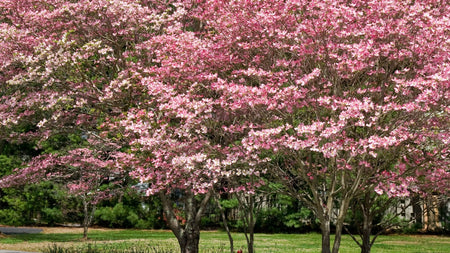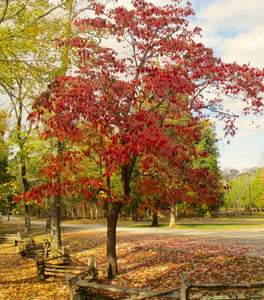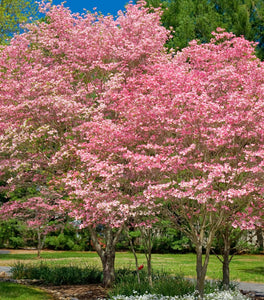
Images Depict Mature Plants
Cherokee Brave Dogwood for Sale Online
Cherokee Brave Dogwood (Cornus florida 'Cherokee Brave') is a stunning deciduous tree known for its vibrant, deep pink to red blooms in early spring. This showy variety of flowering dogwood thrives in USDA Hardiness Zones 5-9, reaching a mature height of 15-30 feet with a spread of 15-20 feet. Its eye-catching blooms, which emerge in spring before the leaves, are enhanced by a white center, creating a striking contrast against the rich red petals. Cherokee Brave Dogwood makes a beautiful focal point in the landscape, ideal for garden borders, front lawns, or woodland gardens.
In addition to its spectacular spring blooms, Cherokee Brave Dogwood boasts attractive deep green foliage that turns to brilliant shades of red and purple in the fall, adding year-round interest. The tree also produces small red berries in late summer, which attract birds and other wildlife, making it an excellent choice for nature enthusiasts. The tree's layered branching structure creates a graceful canopy, providing dappled shade in the garden or as an understory tree in wooded areas. This highly adaptable dogwood grows well in full sun to partial shade, preferring moist, well-drained soil.
Low-maintenance and disease-resistant, Cherokee Brave Dogwood is also more tolerant to powdery mildew compared to other dogwood varieties. Its size and hardiness make it a versatile choice for both small and large landscapes. Whether used as a specimen tree or part of a mixed border, Cherokee Brave Dogwood provides a multi-season display of color and interest, from stunning spring flowers to vibrant fall foliage and wildlife-friendly berries. This tree is a must-have for gardeners seeking a beautiful and resilient addition to their landscape.

| Hardiness Zone: | 5-9 |
|---|---|
| Mature Height: | 20 to 25 Feet |
| Mature Width: | 20 to 25 Feet |
| Classification: | Broad leaved deciduous tree, flowering tree |
| Sunlight: | Full sun to part shade |
| Habit: | Medium branching |
| Foliage: | Green; deep red fall color |
| Flower Color: | vibrant red-pink |
| Pruning Season: | No pruning needed |
| Soil Condition: | Any well drained soil |
| Water Requirements: | Water well until established |
| Uses: | Tolerates all soil types and full sun |
How to Care for Cherokee Brave Dogwood
Be sure to read our planting instructions to ensure a healthy and happy Cherokee Brave Dogwood for years to come!
How do I Plant a Cherokee Brave Dogwood Tree?
To plant a Cherokee Brave Dogwood Tree, choose a location with well-drained soil and full sun to partial shade, as this tree thrives in areas where it can receive some direct sunlight but also benefits from afternoon shade in hotter climates. Begin by digging a hole that is twice as wide and just as deep as the root ball to allow the roots to spread easily. Place the tree in the hole, ensuring the top of the root ball is level with the surrounding soil. Backfill with soil, gently firming it around the roots to eliminate air pockets, and water thoroughly to help establish the roots. Adding a 2-3 inch layer of mulch around the base of the tree will help retain moisture and regulate soil temperature. During the first growing season, keep the soil consistently moist by watering deeply once or twice a week, especially during dry periods. The Cherokee Brave Dogwood prefers slightly acidic to neutral soil, so adding compost or organic matter can improve soil quality and promote healthy growth. Be sure to space the tree about 15-20 feet from other plants to allow room for its mature size and spread. With proper planting and care, your Cherokee Brave Dogwood will reward you with vibrant red-pink blooms in spring, stunning fall foliage, and wildlife-friendly berries, making it a beautiful and low-maintenance addition to your landscape.
How do I water Cherokee Brave Dogwood Tree?
To water a Cherokee Brave Dogwood Tree, it’s important to keep the soil consistently moist, especially during the first few years after planting as the tree establishes its root system. Water deeply once or twice a week, ensuring the water penetrates the root zone. Deep watering encourages the roots to grow deeper, making the tree more drought-tolerant over time. During hot, dry periods or when there is little rainfall, increase the frequency of watering to ensure the soil doesn’t dry out. Applying a 2-3 inch layer of mulch around the base of the tree will help retain moisture and regulate soil temperature, reducing the need for frequent watering. Once established, Cherokee Brave Dogwood becomes more drought-tolerant but still prefers moist, well-drained soil. Natural rainfall may be sufficient for mature trees, but it’s essential to monitor the soil during extended dry periods. If the top 1-2 inches of soil feel dry, it’s time to water deeply. Be cautious not to overwater, as the tree can be sensitive to waterlogged conditions, which may lead to root rot. Proper watering ensures healthy growth, abundant spring blooms, and vibrant fall foliage, allowing your Cherokee Brave Dogwood to thrive and add beauty to your landscape.
How do I fertilize Cherokee Brave Dogwood Tree?
To fertilize a Cherokee Brave Dogwood Tree, apply a balanced, slow-release fertilizer in early spring, just as new growth begins. A general-purpose fertilizer with a 10-10-10 or 12-4-8 ratio provides essential nutrients like nitrogen, phosphorus, and potassium, promoting healthy foliage, strong root development, and vibrant blooms. Spread the fertilizer evenly around the base of the tree, staying a few inches away from the trunk to avoid damaging the roots. After applying, water thoroughly to help the nutrients penetrate the soil and reach the root zone. Fertilizing once a year in early spring is usually sufficient to keep your Cherokee Brave Dogwood thriving throughout the growing season. For an organic approach, you can top-dress the soil with compost or well-rotted manure, which will enrich the soil and slowly release nutrients over time. It’s important to avoid over-fertilizing, as too much nitrogen can lead to excessive leafy growth at the expense of blooms. By providing the right nutrients, you’ll encourage the Cherokee Brave Dogwood to produce its stunning red-pink flowers in spring and maintain its healthy, dark green foliage throughout the summer. Proper fertilization also enhances the tree’s ability to develop brilliant fall colors and support its wildlife-friendly berries, making it a beautiful and robust addition to your landscape.

How Do I Prune a Cherokee Brave Dogwood Tree?
To prune a Cherokee Brave Dogwood Tree, the best time is in late winter or early spring, before new growth begins. Start by removing any dead, damaged, or diseased branches to improve the tree’s overall health and structure. Use clean, sharp pruning shears to make cuts just above a healthy bud or lateral branch. Next, thin out any crowded or crossing branches to allow better air circulation and light penetration, which encourages strong growth and abundant blooms. Pruning during the dormant season helps minimize stress on the tree and promotes healthier, more vigorous growth when the growing season starts. If you want to control the size and shape of your Cherokee Brave Dogwood, light pruning can be done to maintain its natural, rounded canopy. Avoid heavy pruning, as this can reduce the number of flowers for the upcoming season, as dogwoods bloom on old wood. Instead, focus on removing only a few interior branches each year to keep the tree balanced and to promote new growth. Regular light pruning ensures your Cherokee Brave Dogwood will continue to produce its stunning red-pink flowers in spring, maintain its attractive branching structure, and display beautiful fall foliage, enhancing the overall beauty and health of your landscape.






















